The first stage will take the mine through the first five years of open pit production at an average annual rate of 248,000 oz. of gold. The average grade will be 1.57 grams gold per tonne, and 5.5 million tonnes of mineralized material will be passed through the mill. The initial capital expenditure will be C$592 million, which will be repaid in two years.
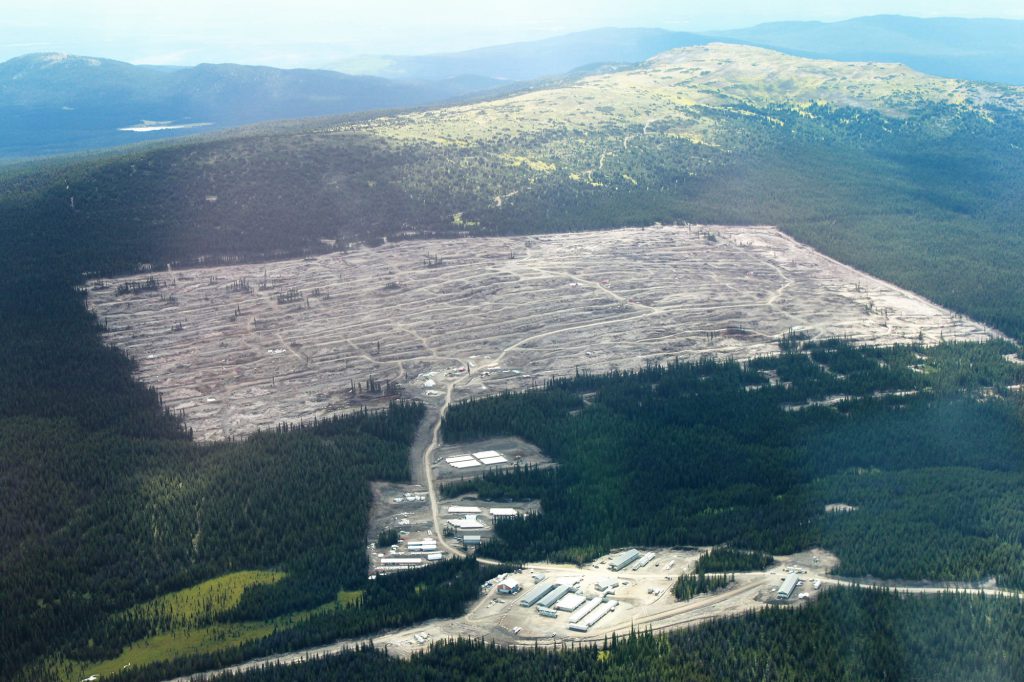
Phase 2 covers expanded production in years six through 10, treating 12 million tonnes of mineralized material each year. Output will be 420,000 oz. gold annually from ore grading 1.17 grams gold per tonne. This phase has a capex of C$426 million.
In phase 3, 20 million tonnes of mineralized material will be mined and milled in years 11 through 17. During this phase, annual output will be 442,000 oz. gold from material with a head grade expected to grade 0.74 gram gold per tonne.
The Blackwater mine has an expected life of 23 years. During the last six years, as ore is exhausted, the grade will drop to 0.31 gram gold per tonne and recovery will shrink to 168,000 oz. per year. This may not be the end of the project, however, as the orebody is open to the north, northwest and at depth to the south.
The Blackwater deposit has proven and probable reserves of 334.0 million tonnes grading 0.75 gram gold per tonne for 8 million oz. of contained gold and 5.8 grams silver per tonne for 62.3 million ounces.
The base case for the initial pit development relied on a cut-off grade of 0.20 gold-equivalent per tonne. The measured and indicated portion stands at 427.1 million tonnes averaging 0.65 gram gold and 5.5 grams silver. Total contained metal is 8.9 million oz. of gold and 75.8 million oz. of silver. The inferred portion is 16.9 million tonnes at 0.45 gram gold and 12.8 grams silver, containing 246,000 oz. of gold and 6.9 million oz. of silver.
The Blackwater project has an after tax net present value (at a 5% discount rate) of C$2.25 billion and a levered after tax internal rate of return at 50%.
Blackwater is not the only mineralization identified on the 1,500 sq. km property. The company has also outlined another orebody, called Capoose, which contains indicated resources of 14.2 million tonnes grading 0.43 gram gold per tonne and 20.8 grams silver per tonne (0.73 gram gold-equivalent) for 333,000 gold-equivalent ounces and inferred resources of 64.07 million tonnes grading 0.29 gram gold per tonne and 23.2 grams silver per tonne (0.62 gram gold-equivalent) for 1.28 million gold-equivalent ounces.
Artemis acquired the Blackwater property from New Gold in August 2020, and work is progressing apace – permitting, environmental, grade control and geotechnical drilling, metallurgical tests, a B.C. Hydro study, and mill proposals. Expect to see the definitive feasibility study by mid-2021. Construction could start in the second quarter of 2022.
On May 10, the company announced an equity financing of up to C$156 million, which will be used to make its final cash acquisition payment to New Gold, and fund permitting and development costs for Blackwater.
Artemis has a market capitalization of C$640 million.
Mistango River Resources
Mistango River Resources (CSE: MIS) has two projects in northern Ontario: the former Omega gold mine near Larder Lake and the Kirkland Lake West project. Both are promising and have attracted investments from Kirkland Lake Gold (TSX: KL; NYSE: KL; ASX: KLA).
In April, Kirkland Lake Gold picked up a 9.9% equity stake in the junior. Under the strategic partnership, and Mistango entered into a strategic partnership, Kirkland Lake Gold has also been granted an option to earn a 75% interest in both projects by spending C$60 million on them.
The Omega mine operated from 1926 to 1928 and again from 1936 to 1947 when it produced a total of 215,000 oz. of gold. There is good reason to rekindle interest in the property. A historic, non-compliant resource estimate completed in 2013 speculated that 585,000 oz. of gold remain in the ground.
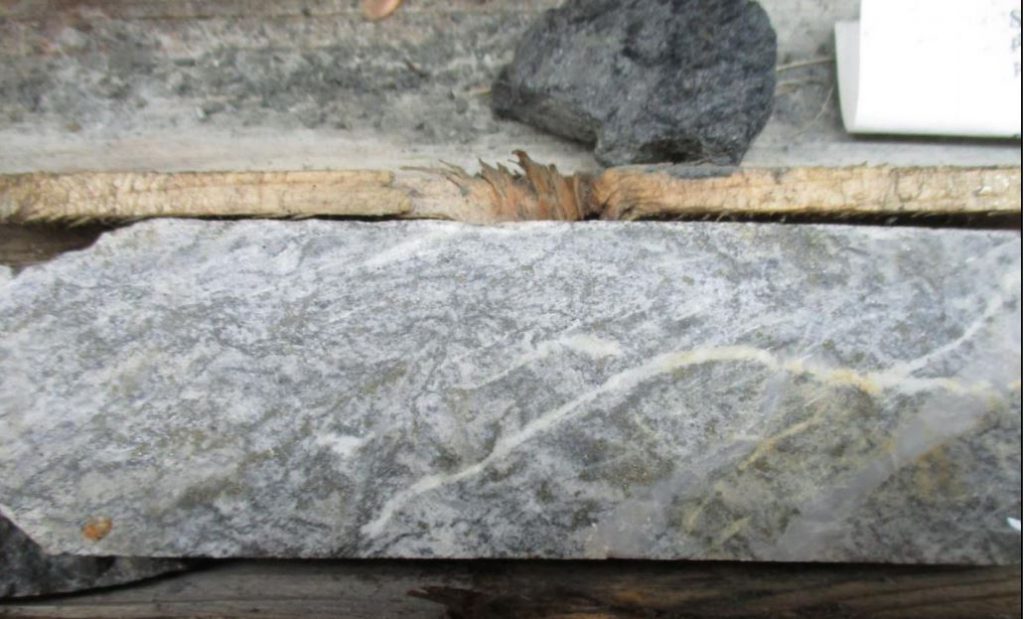
Zones above 130 metres above sea level that could be pitted contain 4.92 million indicated tonnes at 1.39 grams gold per tonne and 3.35 million inferred tonnes averaging 1.8 grams gold, using a 0.5 gram cut-off. These 43-101 compliant resources contain 219,438 oz. and 190,900 oz., respectively.
Deeper ore that could be recovered using underground methods contain 3,000 indicated tonnes at 3.19 grams gold, and 1.3 million inferred tonnes at 4.0 grams gold, using a 3-gram cut-off. Contained ounces are estimated to be 370,000 oz. and 174,500 oz., respectively.
Of equal interest and currently being drilled is the 4,300-hectare Kirkland West gold property, west of and adjacent to Kirkland Lake Gold’s high-grade Macassa mine. This property hosts the convergence of major mineralized structures including potential extensions of the Main Break, Amalgamated Break and the Larder-Cadillac Fault Zone. It includes the small historic Baldwin gold mine that produced an estimated 43 oz. of gold. Old, non-compliant resource numbers include 4,600 tonnes grading 21.9 grams gold.
There is a 10,000-metre drill program currently underway at Kirkland West. Work at the Baldwin target is complete, and has moved on to the Eby zone. Historical drilling showed this to be an area of narrow, high grade gold-quartz veins. An area where wall rock returned 26.1 metres grading 0.34 gram gold will be tested.
Mistango spent about C$803,140 on its 2020 exploration work.
The company has a market capitalization of about C$10.9 million
Pure Gold Mining
North America’s newest high grade gold producer is Pure Gold Mining (TSXV: PGM; LSE: PUR), which poured first gold at its mine in Red Lake, Ontario, in December 2020. Production through the mill began at a rate of 800 tonnes per day, but an optimization program is underway to take the rate to 1,000 tonnes daily.
The optimization program has both a mining and milling component, and the existing shaft and hoist that served the former Madsen gold mine are being recommissioned. The company has also accelerated its program to access the 8 zone and other deeper, high grade zones by developing the main ramp this year.
Studies will begin this year on expanding the project to 1,200 tonnes per day or more. This will involve integrating satellite deposits, converting resources to reserves and extending mine life as well as boosting mining and milling rates.
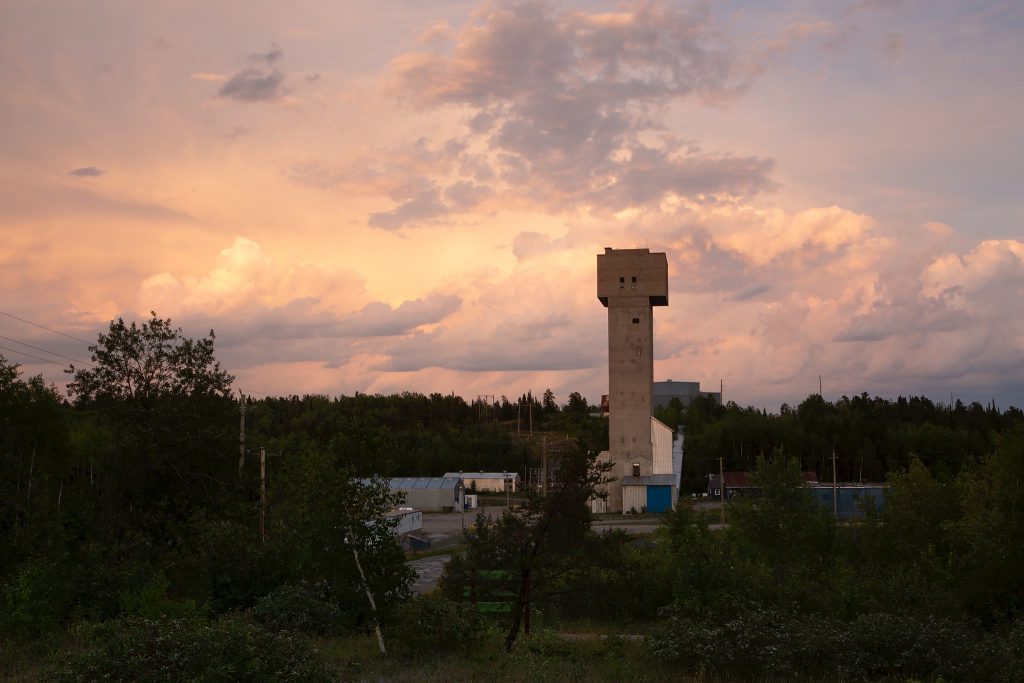
A new resource estimate is expected in the next few months. To a depth of 1,200 metres at the time of writing, the PureGold mine has probable reserves of 3.5 million diluted tonnes grading 8.97 grams gold per tonne and containing over 1.0 million ounces. There were 7.2 indicated tonnes at 8.9 grams gold containing 2.1 million oz., and 1.9 million inferred tonnes at 7.7 grams gold containing 467,000 ounces. Resources are inclusive of reserves.
The Red Lake area has produced over 30 million oz. of gold in the past 100 years, and some mines reach as far below surface as 3,000 metres. So it’s no surprise that Pure Gold is pursuing what may be a high grade game changer, the 8 zone. It will be the target of underground drilling by the end of this year, but it has already returned 466 grams gold per tonne over 4.3 metres, 342.4 grams gold over 5.5 metres, and 120.4 grams gold over 8.2 metres.
Pure Gold’s property also contains several active surface exploration targets. The No. 1 vein is open at depth and recently returned 16.1 grams gold over 2 metres. Derlak, a deep extension of the Main resource, has had only limited drilling and seismic work but shows intense alteration with anomalous gold. The Treasure Box, which returned 19.2 grams gold over 1.1 metres, is situated on the same contact as Russet South and the 8 zone. The Gap zone between Russet South and the mine has shown visible gold in cores although only limited drilling on seismic responses has been done.
The Wedge target will be the core component of expansion to 1,200 tonnes per day. It is known to a vertical extent of 500 metres and stepped out 200 metres along strike. It recently returned 16.6 grams gold over 5.0 metres. It has indicated resources of 122,000 tonnes grading 10.3 grams gold per tonne and contains 56,000 ounces. The inferred portion stands at 307,000 tonnes grading 8.0 grams gold for 79,000 ounces.
Pure Gold Mining has a market capitalization of about C$550 million.
QuestEx Gold & Copper
QuestEx Gold & Copper (TSXV: QEX; US-OTC: CLASF) is working on five projects — Castle, KSP, King Pin, North ROK, and Inel — in British Columbia’s Golden Triangle and Sofia gold property in the Toodoggone area. The company holds 100% interests in all of these properties.
One of the more active programs has been mounted at the Castle gold-copper property, where the potential of the Castle-Saddle trend is being sought. The trend is 10 km long, and QuestEx controls 6.5 km of it. The topography includes valleys that may be suitable for tailings impoundment, low elevation sites for potential portals, and offers open pit potential as well.
The Castle prospect is a copper-gold porphyry in the central part of the property. The Gordon vein on the north side of Quash Creek hosts gold-silver mineralization. Earlier this year, QuestEx sampled 22 grams gold per tonne and over 100 grams silver from an outcrop at Castle.
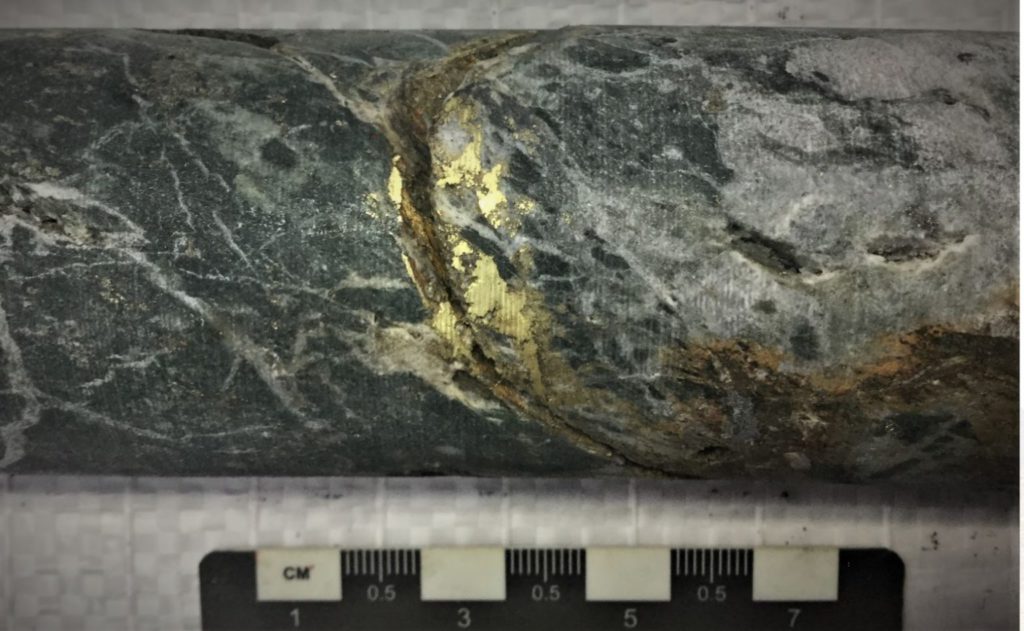
The North ROK property, 15 km northwest of the producing Red Chris copper mine, is another copper-gold porphyry. In 2014 QuestEx announced an initial inferred resource of 142.3 million tonnes averaging 0.22% copper and 0.26 gram gold per tonne using a 0.20% copper-equivalent cut-off grade.
The Kingpin property abuts the former Granduc copper mine and runs northwest to the QuestEx’s own KSP property. The company intends to publish a 43-101-compliant resource estimate for the Inel zone at KSP where drilling once intersected a spectacular 4,470 grams gold over 0.5 metre. It has also identified 335 mineral occurrences at Kingpin.
Last year the Sofia gold property received a share of exploration attention, as well. A 4.4-km-long structural corridor is highly prospective for porphyry copper-gold and has vein related gold mineralization. Several drill-ready targets have been chosen as the hunt continues for gold veins and for copper-gold zones.
QuestEx raised C$11.1 million for exploration and other needs in April 2021.
QuestEx Gold & Copper has a market capitalization of about C$44 million.
Sokoman Minerals
Sokoman Minerals (TSXV: SIC; US-OTC: SICNF) chooses to focus its exploration work in central Newfoundland and Labrador. It holds several gold properties, two of which are currently receiving attention.
Sokoman’s flagship gold property is Moosehead on the Central Newfoundland Gold Trend. This is the same trend as Marathon Gold’s (TSX: MOZ) Valentine Lake project, for which a feasibility study was completed earlier this year. Sokoman has been drilling the property since 2018 and says the geology and mineralization are comparable to that at the Fosterville mine in Australia, which is owned by Kirkland Lake Gold (TSX: KL; NYSE: KL; ASX: KLA).
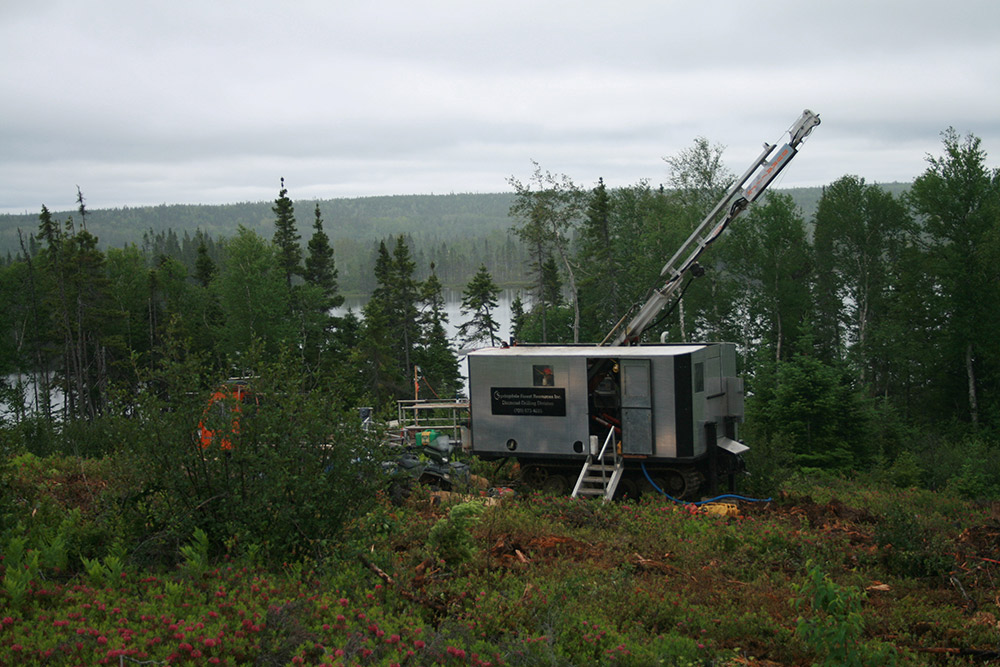
Highlights from the ongoing sixth phase of drilling, which began in 2020, included 4.6 metres of 47.20 grams gold per tonne in the Footwall splay and 8.1 metres of 68.70 grams gold in the Main zone. At the South Pond zone, undercutting high grade gold float material, drilling returned 4.2 metres of 64.0 grams gold, including 1.20 metres at 223.6 grams gold. In April, the Footway splay returned 11.6 metres of 21.07 grams gold, including 5.1 metres of 30.82 grams gold and 3.5 metres of 12.39 grams gold, including 1.5 metres of 28.57 grams. One hole, collared in a visible gold-bearing quartz vein, returned 510 metres of 15.51 grams gold, including 2.8 metres of 27.68 grams.
Sokoman has doubled its phase 6 drilling to 20,000 metres, a program that is fully funded. The Eastern and Western trends, including the Footwall splay will be tested. Plans also call for drilling magnetic, till, soil and float targets along the 8-km strike length of the main structure.
The company’s other promising gold prospect is Fleur de Lys, which was acquired in March. It is on the Baie Verte Peninsula and south of the successful gold mine that is part of the Pointe Rousse project belonging to Anaconda Mining (TSX: ANX; US-OTC: ANXGF).
Fleur de Lys is similar to structurally controlled, vein hosted Dalradian-style orogenic mineralization in the northern United Kingdom. Similar gold deposit include Curraghinalt in Northern Ireland and Cononish in Scotland. Sokoman is planning a two-year prospecting and sampling program to follow up on gold anomalies in lake sediments and tills.
Sokoman closed a C$5.5 million private placement in April 2020, followed by a subscription of C$980,000 by Eric Sprott. This gives Sprott a 19.7% interest in the company.
Sokoman Minerals has a market capitalization of about C$78 million.
Tudor Gold
Tudor Gold (TSXV: TUD; US-OTC: TDRRF) is advancing its flagship Treaty Creek gold project in British Columbia’s Golden Triangle. This is a joint venture between Tudor Gold, which owns a 60% stake, and Teuton Resources (TSXV: TUO; US-OTC: TEUTF) and American Creek Resources (TSXV: AMK; US-OTC: ACKRF), each of which holds a 20% interest.
The property borders the KSM property of Seabridge Gold (TXX: SEA; NYSE: SA) and the Brucejack gold mine of Pretium Gold (TSX: PVG; NYSE: PVG).
In March, Tudor published its first resource estimate for Treaty Creak, outlining a resource with a total of over 27 million gold equivalent ounces; 19.4 million oz. gold-equivalent in the measured and indicated category and another 7.9 million gold-equivalent oz. in the inferred category.
Using a 0.30 gram gold equivalent cut-off grade, the pit constrained measured and indicated resource stands at 609.8 million tonnes grading 0.65 gram gold per tonne, 3.2 grams silver per tonne and 0.06% copper, for 14.15 million contained gold equivalent ounces. The pit-constrained inferred portion measures 139.4 million tonnes grading 3.6 grams gold, 0.06 gram silver and 0.04% copper, or 3.46 million contained gold equivalent ounces.
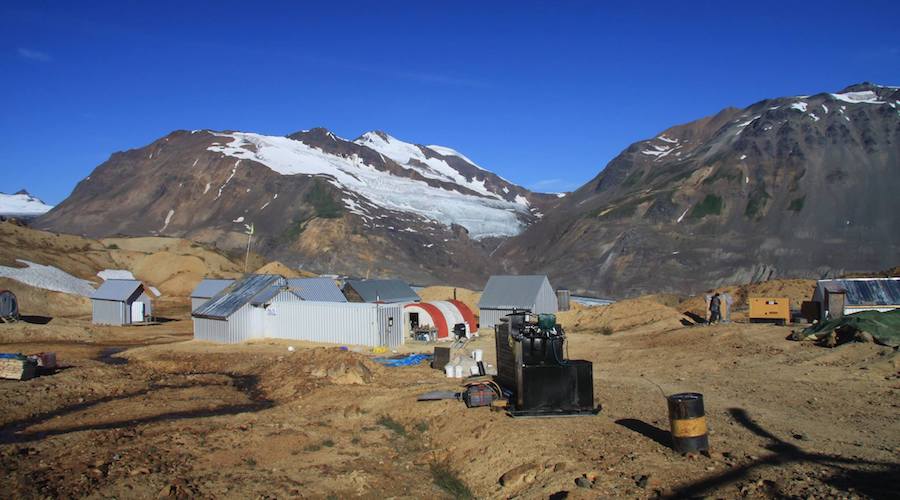
The out-of-pit resource was also calculated at a cut-off grade of 0.46 gram gold equivalent. The measured and indicated portion totaled 205.9 million tonnes grading 0.7 gram gold, 4.6 grams silver and 0.07% copper, or 5.26 million contained gold equivalent ounces. The inferred resource equals 172.3 million tonnes at 0.72 gram gold, 4.4 grams silver and 0.06% copper, containing 4.43 million gold equivalent ounces
Drilling continues this year, primarily at the Goldstorm, Perfect Storm, and Eureka (Treaty gossan) zones. The Goldstorm zone has three separate mineralized horizons, each with long intercepts of good grades: 3.22 grams gold equivalent over 82.5 metres in the 300 horizon; 2.15 grams gold-equivalent over 75 metres in the CS-600 horizon; and 0.98 gram gold-equivalent over 550.6 metres in DS-5. Gold equivalent includes assayed values of gold, silver and copper.
Tudor recently closed a C$9.6 million private placement with Teuton to fund this year’s exploration work and for working capital.
Tudor Gold has a market capitalization of about C$495 million.
Victoria Gold
Victoria Gold’s (TSX: VGCX; US-OTC: VITFF) Eagle mine is the Yukon’s newest and largest gold producer. The heap leach mine is on the 555 sq. km Dublin Gulch property, about 85 km north of Mayo and 375 km north of Whitehorse. Eagle began commercial production on July 1 2020 and produced 116,644 oz. of gold last year. This year the company’s production guidance is for between 180,000 and 200,000 oz. gold at all-in sustaining costs of between $1,050 and $1,175 per ounce.
Eagle is an open pit mine with a carbon-in-leach plant and all-season facilities for 300 employees. The mine is ramping up to full production of 200,000 oz. gold per year, and expansion and mine life extension are likely, the company says. The pit is currently 350 metres deep, but the orebody is known to extend to a depth of at least 650 metres.
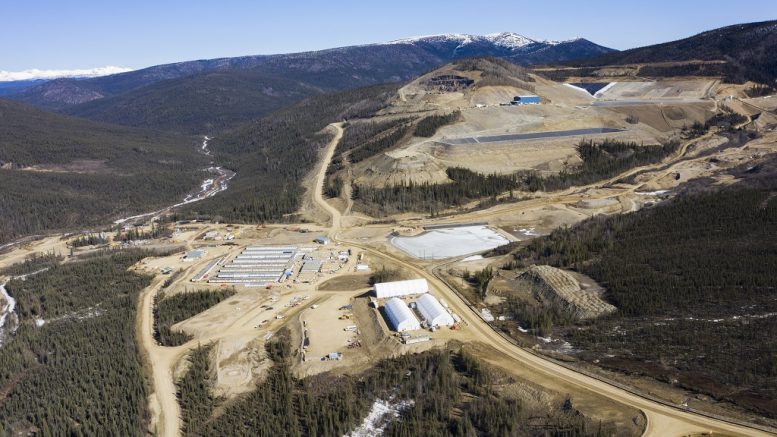
As part of its “Project 250k” the company is working to grow its output to 250,000 oz. a year by 2023.
The Eagle mine is made up of the Eagle and Olive deposits. Current reserves across the two total 155 million tonnes grading 0.65 gram gold per tonne, for a total of 3.3 million oz. gold.
The Dublin Gulch property stretches over an area of about 44 km by 15 km, and there is ample exploration opportunity. One area that received attention last year was the Raven target. Drilling there has returned 3.36 grams gold per tonne over 7.7 metres, 5.54 grams gold over 2.1 metres, 2.35 grams gold over 15.9 metres, and 0.57 grams gold over 101.5 metres. Visible gold was intersected in about 35% of the holes. The strike length has been tripled to more than 750 metres.
This year the company plans to spend about C$12.5 million on exploration. In addition to Raven, regional targets include Nugget, Lynx, VBW/Falcon and Olive-Shamrock. Victoria also plans to complete trenching and collect soil samples across its property.
On May 11, Coeur Mining (NYSE: CDE) announced it is acquiring a 17.8% stake in Victoria from Orion Mine Finance. After the transaction, Orion will still be the company’s largest shareholder with 11.5 million shares.
Victoria Gold has a market capitalization of about C$942 million.
Wallbridge Mining
Eighty kilometres east of the producing Detour Lake mine that belongs to Kirkland Lake Gold (TSX: KL; NYSE: KL; ASX: KLA), Wallbridge Mining (TSX: WM; US-OTC: WLBMF) is fast tracking exploration and development of its flagship Fenelon gold project in Quebec, 75 km northwest of Matagami.
Wallbridge acquired the Fenelon property in 2016. It has a strike length of 1.8 km identified to date, and has yielded three new discoveries since 2019. All zones are open and underexplored. The company says to expect its first Fenelon resource estimate in the third quarter of 2021.
Since it began investigating the property, Wallbridge has expanded the Fenelon gold system with the discovery of the Area 51 zone in late 2018 and the Lower Tabasco-Cayenne shear zone in 2019. Both contain new geologic settings with extensive vein- and shear-hosted gold mineralization. Bulk samples were subjected to metallurgical tests in both 2018 and 2019. Gold recovery rates were achieved between 94% and over 99% from samples grading 14.94 to 31.88 grams gold per tonne .
The current C$75 million exploration and development program is fully funded, thanks in part to a successful C$20 million bought deal financing this spring. Work has begun on the 2021 surface drill program of 170,000 metres. A two-year underground exploration program will also begin this year to establish drilling platforms.
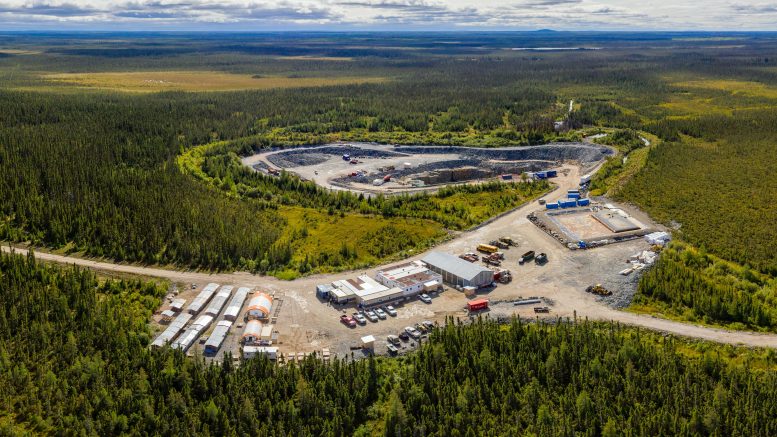
Earlier this month, the company released assays that confirm the grade and geometry of the central portions of the Tabasco-Cayenne and Area 51 zones and expand the mineralized footprint. Highlights included 8.57 grams gold per tonne over 10.35 metres and 16.67 grams gold over 4.55 metres from Tabasco-Cayenne and 284 grams gold over 0.60 metres and 2.09 grams gold over 24.15 metres from Area 51.
Since its Fenelon property acquisition, Wallbridge has assembled a district scale land package covering more than 900 sq. km and several more mineral occurrences. Look for reports from properties such as Detour East, Casault, Doigt, Martinière, Harri, Jérémie and Grasset in the future.
Wallbridge has a market capitalization of about C$519 million.
(This article first appeared in The Northern Miner)




